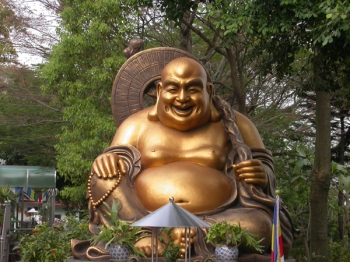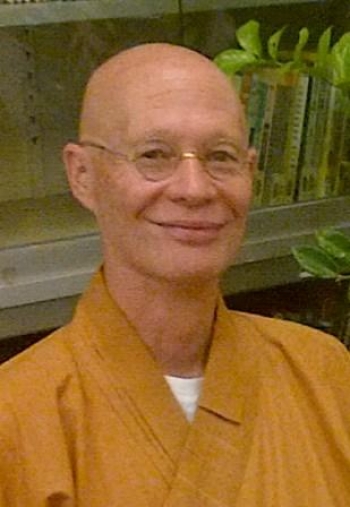Some years ago in the city of Da Tong in Shaanxi Province in China a local made some suggestions to an ill neighbour as to how he might become better. He suggested six things the ill person should do and as a result he became restored to full health. The neighbours saw that there was value to this approach and started to also follow the steps. They felt that this helped them each individually and brought them together. Over time more and more people found these methods valuable and special retreats in Buddhist Temples grew from this, spreading throughout China.
The six steps are grounded in Pure Land Buddhism and the gradual proliferation of retreats is almost entirely driven by the laity in a movement called Di Zang Qi (named after the Bodhisattva Di Zang).
The Six Steps are:
1. Being Vegetarian
2. Chanting the Sutra of the Past Vows of the Earth Store Bodhisattva
3. Prostrating in accordance with the Eighty-Eight Repentance Ceremony
4. Releasing and feeding animals
5. Conducting one good deed a day
6. Reciting the name of the Amitabha Buddha.
Step 1. Being Vegetarian
This step is in line with the Bodhi Mind of great compassion towards all sentient beings. It has a spiritual foundation as well as a health foundation. As Buddhists and spiritual practitioners we create immense impure karma through the passive acceptance of killing of animals for meat. A vegetarian diet is absolutely essential for profound meditation practice. What is more is that there are proven health benefits from being vegetarian. All the necessary vitamins and minerals are available in a balanced vegetarian diet.
Step 2. Chanting the Sutra of the Past Vows of Earth Store Buddha
The Sutra of Earth Store Bodhisattva points the way to developing the intense wish to free all sentient being from suffering with re-birth in the Pure Land. It also forms the basis for what is known in Chinese Buddhism, and indeed Chinese culture, as filial piety. The relational connection between ourselves and our parents is a vital key to one’s well-being. So often in our societies this relational connection is strained. Confucius stated that “a superior person attends to the roots. When the roots are set firmly the Tao can spring forth.” Our parents are our roots and yet in modern society our parents are so often neglected and often placed in nursing homes in their later years.
In Naikan meditation, a reflective meditation formed in the Japanese Jodo (Pure Land) movement, we commence our inner examination with the roots, by examining our relationship with mother and father. It is from these first relationships that our entire relational life springs forth. In Naikan we examine the great gift we receive and the opportunity to give to these relationships as well as those things we have done and said that have gone to injure or complicate our relationships.
Step 3. Prostrate in accordance with the Eighty-Eight Repentance Ceremony
The word “repentance” as with the words “guilt” and “shame” are stigmatized words in our modern Western therapeutic as well as religious culture. In our modern pop-psychology culture the concepts of guilt and shame are seen to be the root of many emotional problems. We live in a feel-good society so who on earth would want to espouse such concepts? Saying “sorry” for wrong doings is now considered to be potentially damaging to one’s image. Corporations, governments and many other enterprises are even advised by their legal counsels to avoid the word as it may be an admission of guilt leading to costly law suits. This is a sick and grossly insane society which condones the conditions leading to stunted psychological and spiritual growth.
There is no doubt that this step does not sit well with many. Yet, without it, we remain damaged and unable to enter into a bliss that awaits us. One of the world’s most famous and successful recovery programs upon which many recovery programs have been based, Alcoholics Anonymous, have a set of 12 Steps to freedom from the suffering caused by addiction to alcohol. One of those steps speaks of admitting the exact nature of our wrong doings: “Admitted to God, to ourselves, and to another human being the exact nature of our wrongs”. GROW, an international mental health movement also has a 12 Step recovery program of which step 5 states: We made a moral inventory and cleaned out our hearts. The founders of these movements new the power of repentance and the consequential freeing of the soul to grow to its fullest potential and a host of people have been brought into recovery as a result.
The Buddha speaks of “shame”. He does not mean “guilt”. Guilt is something external imposed by others in judgement. It implies a subsequent punishment. This is not Buddhism. Shame is internal. Shame is a personal look at ourselves. We don’t like what we see. “What am I doing to myself? What am I doing to my life?” It has nothing to do with moral codes or priests. It is about your consciousness, not your conscience. To enter a state of pure bliss which is Pure Land requires a radical shift of consciousness. Some time ago I tried to open a glass sliding door in our temple. It came part of the way then became jammed. I pushed and pulled but nothing would move it. On closer examination I discover two small pebbles lodged in the groove along which the door would slide. On removing the pebbles the door was able to open. If we do not remove the karmic residue of the wrongs we have done then there is no way we are able to make a shift in consciousness to a new awakening and new life.
A prostration is a physical act. Our body goes down and face down completely touches the earth. The second part is we rise again. That is in itself a powerful metaphor. When we do a wrong our entire body is involved. A wrong doing is not just a mental activity; it is done with our entire body. In prostrations we engage our entire physical body as well as mind in an act that resonates in our consciousness. That is why meditation must always follow prostrations reconciling body and mind to the Buddha nature within us. The repentance restores our integrity, the integrity of our Amidha Buddha nature. It allows a glimmer of light to filter through the dark mists of timeless karma and for the first time we behold a vision of what can be – our own fullest nature in Buddhahood.
In addition to the psycho-spiritual act of prostrations, there are tremendous health benefits from the point of view of traditional Chinese medicine. Prostrations stimulate both the Du Mo channel, the channel that runs down the centre of the spine as well as the Ren Mo, that channel which runs down the centre of the front of the body. These two channels contain many acupuncture points which direct Qi (Vital energy) to the respective internal organs. Many people have found doing regular daily prostrations to be energizing.
Step 4. Releasing and Feeding Animals
Our Temple has a two and half legged cat. It had one leg cruelly removed by being caught in a rabbit trap when it first came to us. Another leg seemed to have been broken by a fall and set incorrectly. We feed and care for this cat placing it on our lap as we chant or meditate. Many temples in China have a Free Life Pond where fish, turtles and eels are released in order that they may be spared from being killed and used a food in restaurants. Our temple started with three turtles and now have 15 turtles happily living in our very large pond.
Animals are one of the six forms of re-birth and one of the three Evil paths of re-birth in the human world. To be born as an animal means great suffering often at the hands of hunters other animals of prey and human slaughter. We cannot expound world peace as long as we go on slaughtering animals. Even if we do not do the slaughtering ourselves we are by our silent and passive condoning aiding the slaughter. When we show deep compassion to animals we assist the animal to a better re-birth as the love and care we show to them assists in purifying their karmic residue. As we help another to be released from suffering so we by the laws of cause and effect help ourselves to live a life of freedom.
Step 5. Conducting One Good Deed a Day
Many practitioners often think that cultivation is about meditation. While meditation is a very important element in spiritual cultivation it is only part of the story. In the Meditation Sutra the Buddha clearly speaks of the active side of the practice: “One who wishes to be reborn in the Pure Land should cultivate the Three Virtues . . . and doing the Ten Good Deeds.” As practitioners it is not sufficient to think compassion and good. We must actively do good. It is in the doing of good deeds that we are with correct ego-less motivation able to release much karmic obstruction and enable us to live a healthier and happier life. I remember when I worked as a mental health supports facilitator that those patients who became involved in volunteering, for example, had faster recovery from mental illness.
Step 6. Reciting the Name of Amidha Buddha
Central to Pure Land Buddhism is the recitation of the name of Amidha Buddha. This practice is called in Chinese as nien-fo meaning ‘Mindfulness of the Buddha. Cultivators chant either Amituo Fo or Namo Amituo Fo, meaning ‘Praise to Amidha Buddha’. This is also a mantra which enables the cultivator to gradually eliminate karmic residue while at the same time planting seeds of pure karma enabling him to enter Pure Land consciousness. Sometimes the mantra is chanted to music, other times chanted aloud with mala beads, yet other times used in serene intoning in transcendental meditation. When one single mindedly concentrates on the name of Amidha Buddha one enters the timelessness of transcendent light and life; mind and Buddha Mind become one. This is a crucial element in making the shift in consciousness for realizing, that is, being re-born, into Pure Land, Ultimate Bliss and Joy.
The Six Step Program has gained momentum in China over the past four years capturing the interest of monks, nuns and lay people alike. The Di Zang Core Team made up of dedicated lay volunteers many of whom are young senior school and university students drives the program.
I was recently approached by the Core Team to help put together an English program in order to bridge the cultural divide bringing Chinese Pure Land Buddhism alive in a modern and fast paced world.
A pilot English retreat was held at Guang Jue Temple during April the same time as a Chinese speaking retreat. The temple was alive with activity and fresh air poured in through the windows of this one thousand four hundred and seven year old temple. During the final days of the retreat the Young Chinese retreat group was present as well. The English retreat was attended by people from Finland, Germany, Italy, Denmark, Canada, USA and China – a truly multi-national retreat.
















